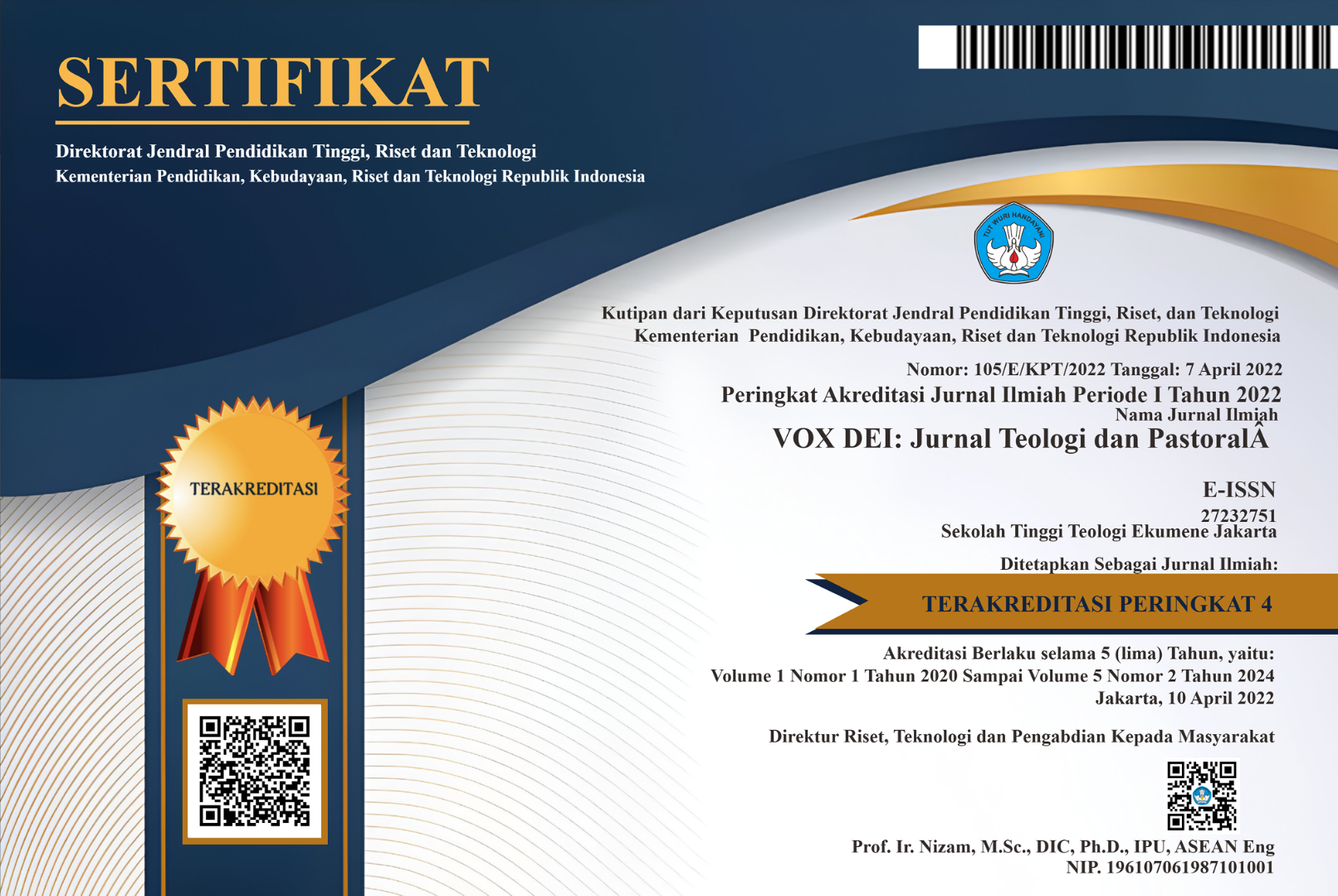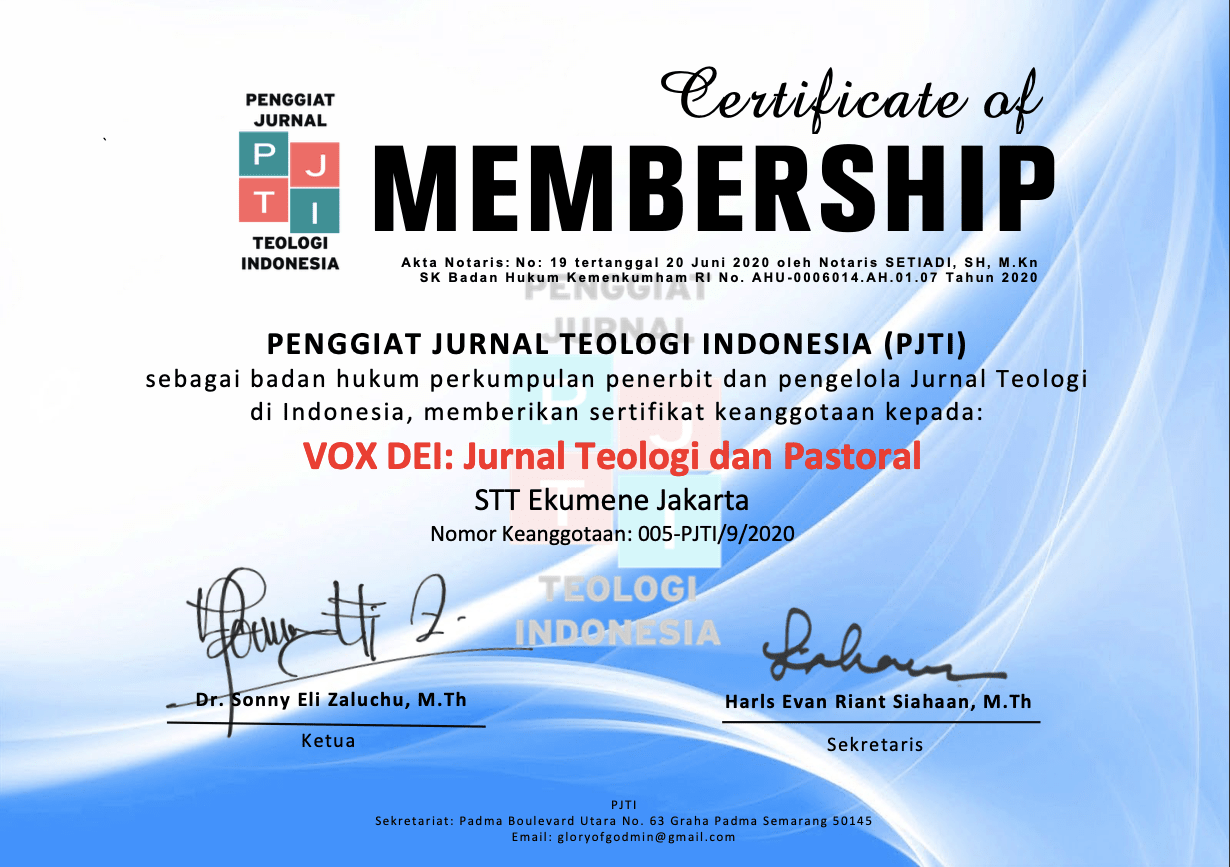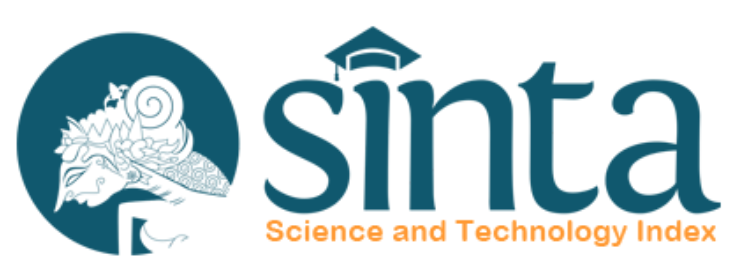RISET IMPLEMENTASI PENGAJARAN TIGA PILAR GEREJA SUARA KEBENARAN INJIL MELALUI METODE EKSPLANATORI - KONFIRMATORI
DOI:
https://doi.org/10.46408/vxd.v1i2.31Keywords:
Holiness, New Heaven, New Earth, Responsibility, Church PillarsAbstract
This research had a purposed was to determine how much the implementation of the teaching of the three pillars of the Bible's Truthful Voice Church (abbreviated as GSKI), then what dimensions are dominant and what background categories are dominant in the teaching of the three pillars. The method that researchers use is a quantitative method with an explanatory-confirmatory approach. The researcher submitted a statement questionnaire to the officials of the Jakarta Gospel Truth's Church. Based on the research results obtained, it turns out that the magnitude of the implementation of the teaching of the three pillars of the GSKI is at a high level, then the dominant dimension is responsibility and the dominant background category is the length of service of church officials. With these results, the recommendation is to maintain a high level by making systematic teaching modules, holding seminars on the three pillars of the GSKI, holding regular meetings between the central board and church officials, and selecting candidates for officials selectively and objectively.
Downloads
References
Hasan, I. (2004). Analisis Data Penelitian dengan Statistik. Jakarta: Bumi Aksara.
J.C, R. (2000). Heaven. (Rossshire: Christian Focus Publications.
Kemdikbud. (2020). KBBI. Retrieved from https://kbbi.kemdikbud.go.id/entri/nurani
Mangum, D. (2014). Holiness, Lexham Theological Wordbook, Lexham Bible Reference Series. Bellingham, WA: Lexham Press.
Pardede, Z. (2019). Rancang Bangun Teologi “Kekudusan” Tentang Hamba Tuhan Sebagai Pemimpin Kristen Menurut Kitab Yosua. KHARISMATA: Jurnal Teologi Pantekosta. https://doi.org/10.47167/kharis.v1i2.20
Prasetio, B. dan J., & Lina, M. (2008). Metode Penelitian Kuantitatif. Jakarta: Raja Grafindo Persada.
Priyatno, D. (2010). Paham analisis statistik data dengan SPSS. MediaKom.
Ritonga, N. (2020). Teologi Sebagai Landasan Bagi Gereja dalam Mengembangkan Pendidikan Agama Kristen. Jurnal Shanan, 4(1), 21–40. Retrieved from http://ejournal.uki.ac.id/index.php/shan/article/view/1766
Sabdono, E. (2019a). Anthroplogy (Rehobot Literature. Jakarta: Rehobot Literature.
Sabdono, E. (2019b). Mencapai Kesucian. Jakarta: Rehobot Literature.
Sabdono, E. (2019c). New Paradigm of Christian Living. Jakarta: Rehobot Literature.
Sabdono, E. (2019d). Surga. Jakarta: Rehobot Literature.
Setio, R. (2012). Isu-isu Pendidikan Teologi di Indonesia.
Soeherman, S. (2003). Tujuan Pengajaran Gereja dan Implikasinya. Veritas : Jurnal Teologi Dan Pelayanan, 4(1), 107–119. https://doi.org/10.36421/veritas.v4i1.101
sproul, R. (2009). Defending Your Faith: An Introduction to Apologetics. wheaton: crossway.
Themes, H. M. (2009). The Accessible and Comprehensive Tool for Topical Studies. London: Martin Manser.
Zaluchu, S. E. (2020). Strategi Penelitian Kualitatif dan Kuantitatif Di Dalam Penelitian Agama. Evangelikal: Jurnal Teologi Injili Dan Pembinaan Warga Jemaat, 4(1), 28. https://doi.org/10.46445/ejti.v4i1.167
















